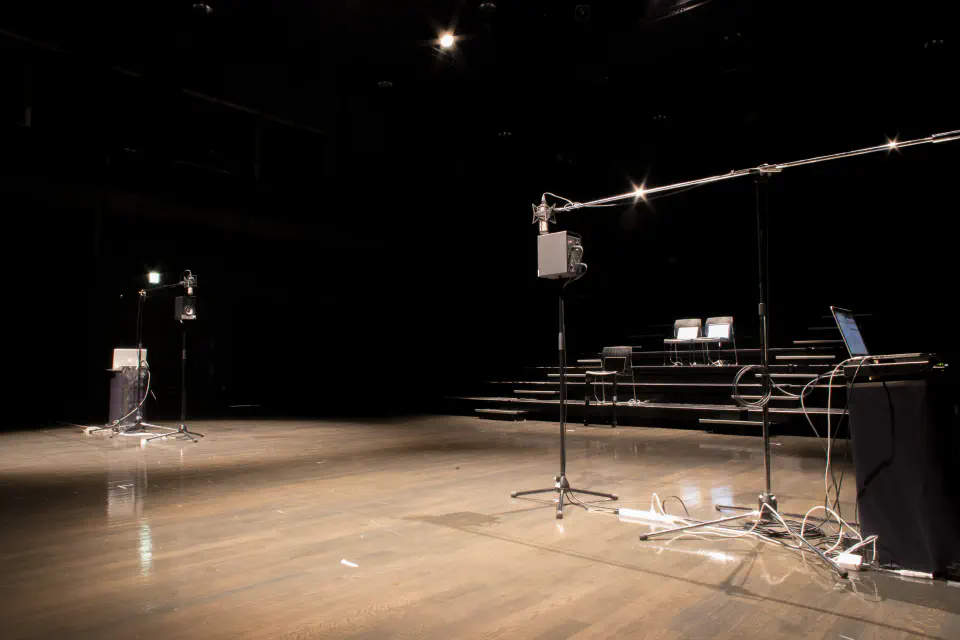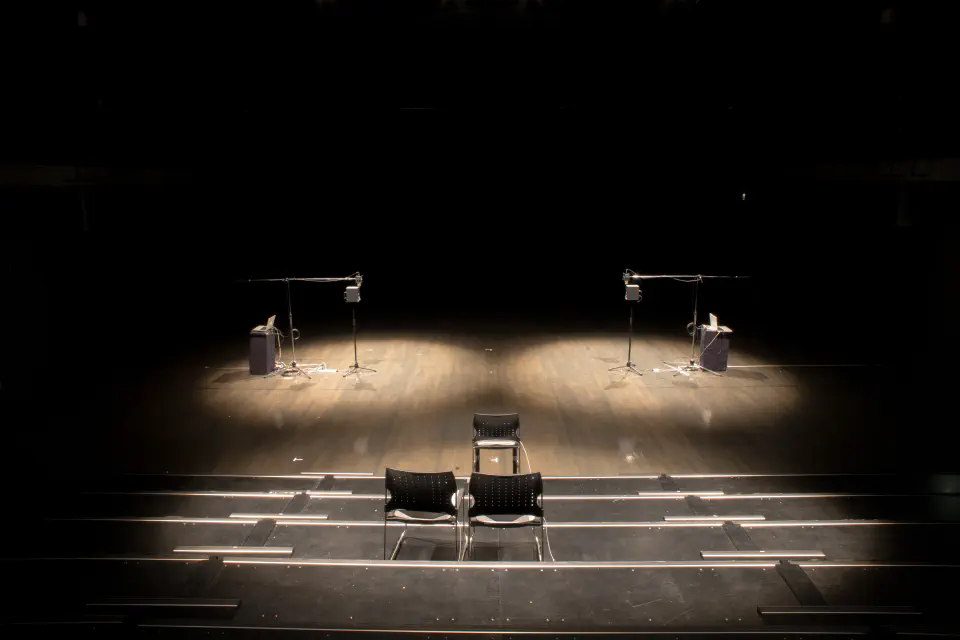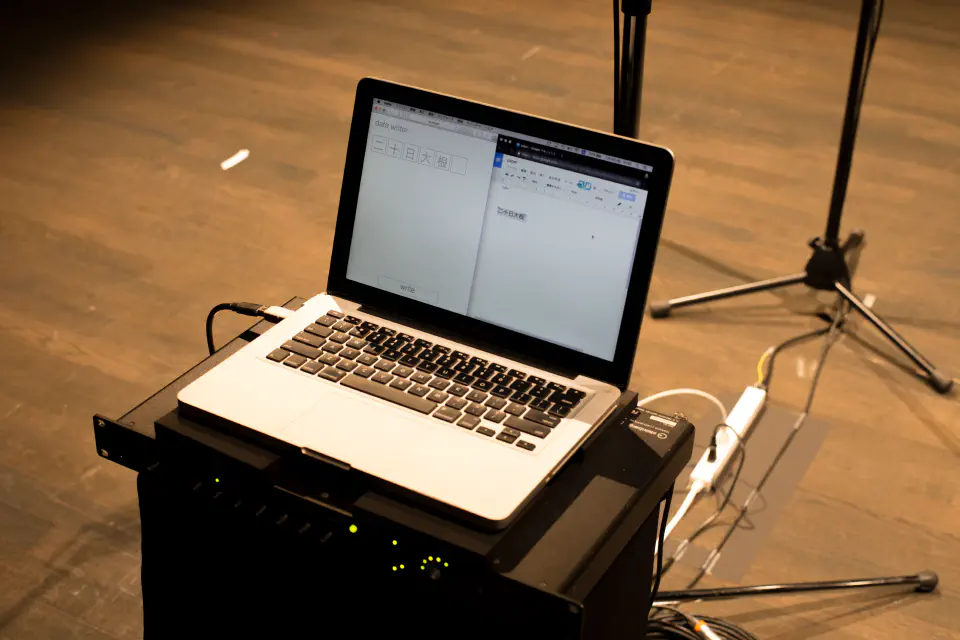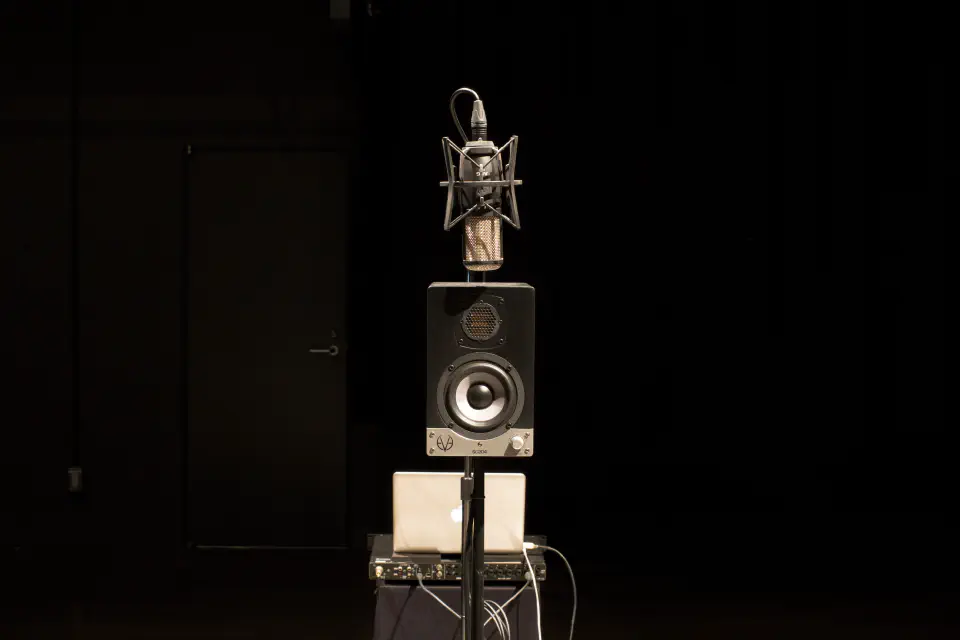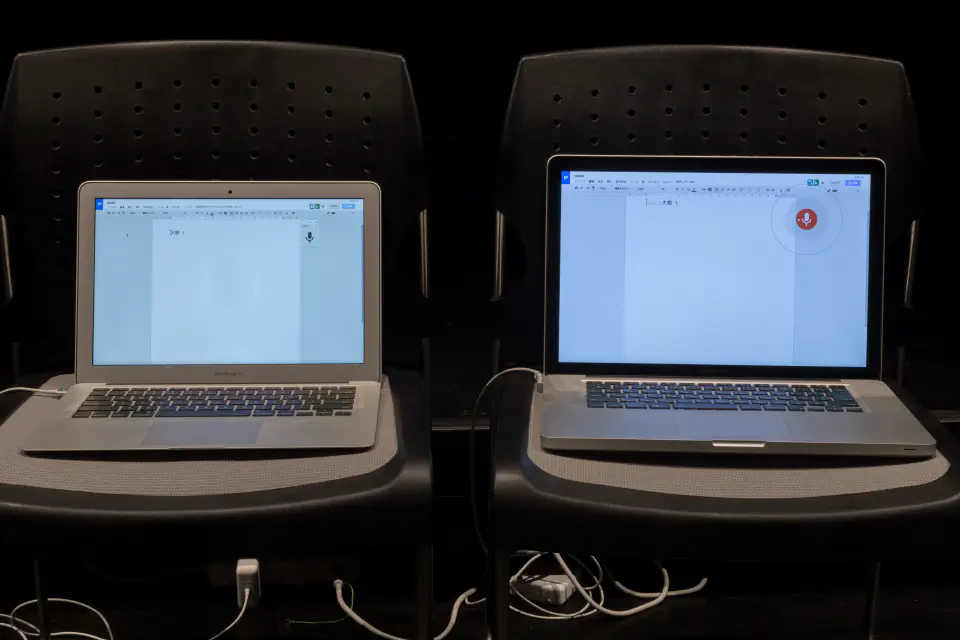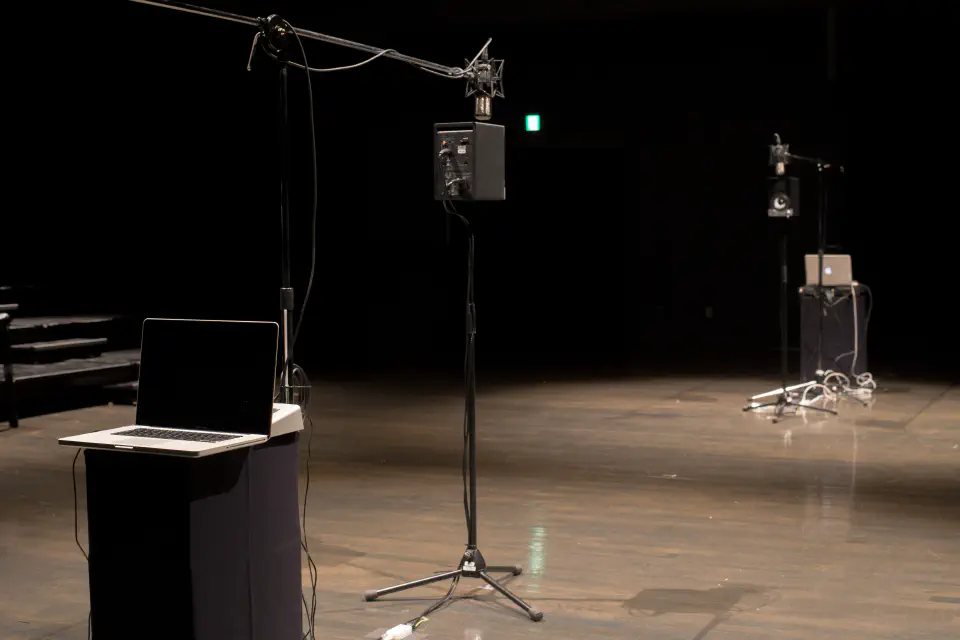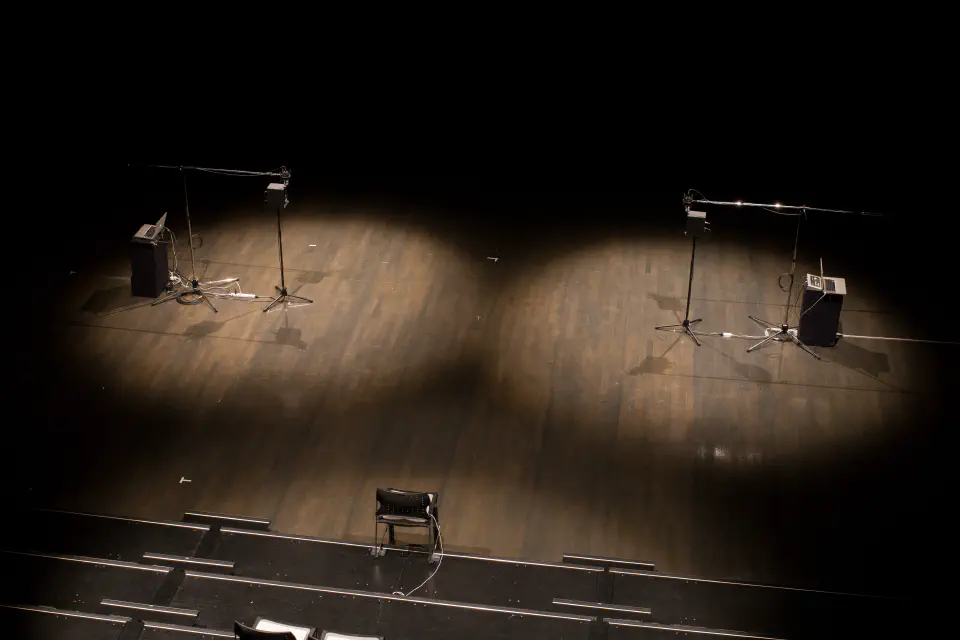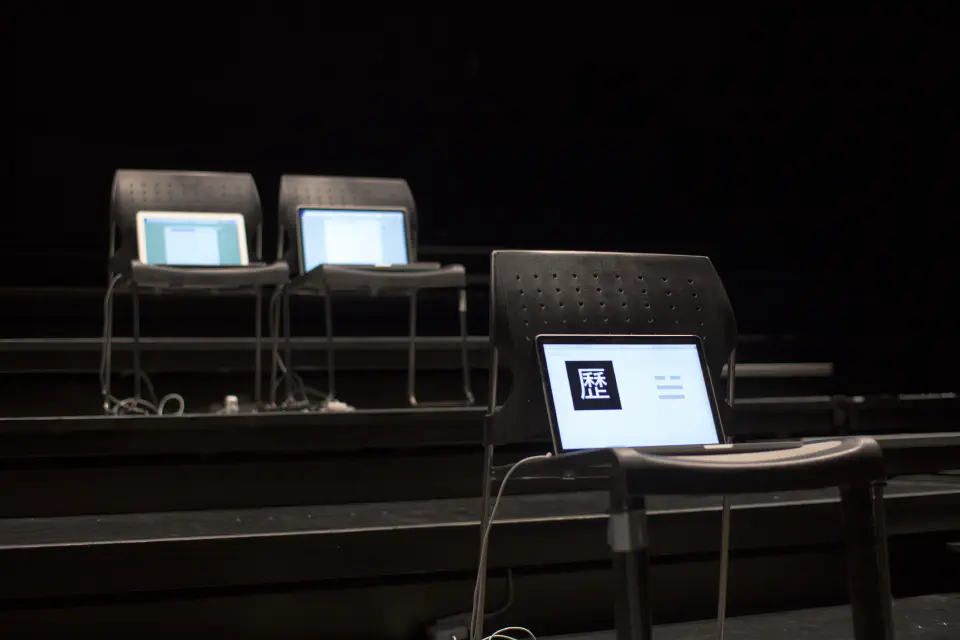2016/11/4~11/9 東京藝術大学 千住キャンパス第7ホールにて展示
- 照明 : 松島州伸、陣内薫 - 記録撮影 : 野口翔平
- 協力 : 阿部壮志、笠原眞由、黒石紗弥子、竹本水花、辻百合香、増田義基、渡辺千加
Acoustic delay line memory is memory apparatus used in short term of 1950s, an early age of electronic computers.
Acoustic delay line memory works as figure above explains. It can store binary data by recirculating sonic pulses as a data sequence from speaker to microphone, microphone to speaker through amplifier.
This work is an over interpretation of acoustic delay line memory.
By combining 2 system that “reproduces sound of same data as it listened”, The whole system has a function of digital memory though individuals have only a function of a communication. Then, when and where the data is stored?
This work suggests the notions of record and memorise something.
文章
Acoustic Delay line memory is the memory apparatus used with early electronic computer in 1950s. Utilizing the fact that sounds take certain time in propagation, if received data is returned back to transmitter, unless communication fail,completely same data will continue circulating. So It works as memory apparatus. John Presper Eckert, developer of this machine, explain that function as follows.
John: The idea is if you had a mercury tank, let’s say you can put 1,000 pulses into one end of the mercury tank before any starts spilling out of the other, this is a memory, but the trouble is, after, say, a millisecond, if the pulses are going in at one every microsecond, it’s gone. But supposing I take the pulses coming out and reshape it and put it in every time. Now the thing will sit there and recirculate, as the saying goes.
Interviewer: So the storage is storing by motion of the mercury?
John: It’s stored by a wave going through the mercury. The mercury’s standing still, but a compression wave is going through it. Particle motion is occurring back and forth, and a wave is transmitting through it. How did I think of this idea? I remembered that when I was a little boy, when I went to the store, my mother would tell me, “I want you to get these four or five things.” Rather than write them down, I did as other little boys probably did when their mother sent them to the store, I repeated these five things to myself over and over again all the way to the store. In this way, my short-term memory at a young age was turned into a long-term memory to get to the store. That’s the same principle. It’s taking this stuff out of the mercury tank and recirculating it through a recirculating path. We built the first UNIVACs with that type of memory, the UNIVAC I.
This metaphor is not so suitable. This phenomenon is similar to rather the phenomenon “Screen burn-in” of CRT Display TV. It means some physical or chemical changes are happens and fixed by repeating some small phenomenon. In acoustic Delay memory, Once transmitting of infomation are prevented or power cable is disconnected,all data are deleted immidiately. But from some point of view, if person go power off, all data in their brain can not be bring out anyway. So if you say that two phenomenon are similar,it may not be wrong.
In this exhibition, the concept of acoustic delay memory are stretched. It is integrated with technology of wireless communication developed after acoustic delay memory is extinct or misusing standard feature of today’s electronic computer. Besides,in this exhibition five electronic computers are used, but no computer works as memory system alone. They interprets infomation each other and try to keep some data.
The sound in this space, if listened by people or not,it works as a distorted gear.Whether that sound has some meaning is not related to the function of the apparatus.
Bringing out or embed some data is similar to turning gear at a glance. But, in fact, it is similar to becoming gear.
How is there difference between adjacent gear is truly machine to human or some other thing?
音響遅延線という装置は1950年代最初期の電子計算機で使われた記憶装置です。 音が伝わるには時間がかかるということを利用し、通信で受け取った情報を送信機に戻してやれば、通信が失敗しない限り全く同じ情報がぐるぐると循環し続け、記憶装置として機能するというものです。この記憶装置の仕組みを開発者であるジョン・プレスパー・エッカートは以下のように説明しています。
エッカート: 例えば、水銀で満たされたタンクがあるとしよう。1000発のパルス音を片方の端から入れて、反対側の端から漏れ出てしまう前までは、それはメモリーと呼べるだろう。 問題は1ミリ秒後のことだ。もしパルスが1マイクロ秒ごとに一つづつタンクから出ていってしまえば、それでお終いだ。しかしここでこのパルスを毎回取り出して、もう一度元の形に整形してもう一度戻したとしたらどうだろう。パルスは言ったとおりに循環し続け同じ状態を保つ。
インタビュアー: ということはその記憶装置は水銀の動きで保存していると?
エッカート: 水銀を伝わる波によって保存しているんだ。水銀は動かずそのままだが、弾性波がその中を通り抜けていく。水銀の分子の前後に動き続ける。そして波はその中を伝搬していく。これをどうやって思いついたと思う?小さい頃のことを思い出そう。買い物に行く時に、母親が私にあれやこれを4~5個買ってきて欲しいと頼んでくる。それを書いてメモするのではなく、多分同じような小さい子供はみんなそうすると思うが、母親に送り出されてから店につくまでの道のり中ずっとその5つのことを自分の中で繰り返し自分に言い聞かせる。 こうすると若い私の短期記憶は店につく頃には長期記憶になっている。同じ原理だ。 音響遅延線も水銀のタンクの中に詰めて電気回路を通して戻して循環させている。私たちはこのタイプのメモリーを使って最初のUNIVAC、UNIVACⅠを作り上げた。
この例えはあまり適切ではありません。この例えはどちらかと言えば陰極線管テレビジョンに同じ映像を長時間映すとその映像が焼き付いてしまうというのに似ていて、ある現象を反復することで物質的な変化が生じ固着するというものです。音響遅延線は一度でも情報の伝達が遮断されればたり、電源が切れればたちまち情報は消えてしまいます。と言ったものの、人間だって電源が切れれば保存されている情報は取り出せないので、似たようなものだと言われるとそれもまあ間違いではないかもしれません。
今回の展示において、音響遅延線たちは拡大解釈されています。遅延線が使われなくなったあとに開発された無線通信の技術を取り入れたり、現在の電子計算機の標準機能を誤用したりしています。また、この展示には5台の電子計算機が使用されますが、どれも単体で記憶装置として機能する事はありません。お互いに情報を解釈しながら、ある情報を保持し続けようとします。
ここで鳴る音は人に聞かれようが聞かれまいが、いびつな歯車として一応機能します。その音が意味を持っていてもいなくても装置にとっては関係のないことです。 何かから情報を取り出したり、何かに埋め込むということは歯車を回しているように思えますが、実のところその時自分が歯車になっているのではないでしょうか。 隣り合っている歯車が本当に機械であったり人間であったり他の何かであることにどれほどの違いがあるのでしょうか。
